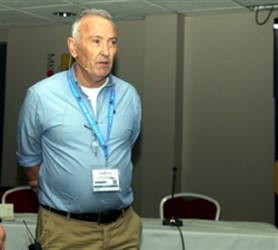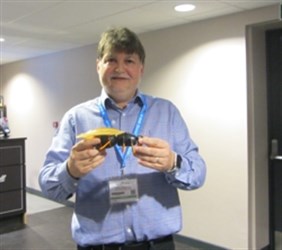One thing stood out about this years PestTech seminar programme. All of the sessions had much more to do with safeguarding wildlife and/or preventing the invasion of pests than they did about actual treatments and control.
For anyone looking in at the industry from outside, this focus on wildlife and prevention would have been surprising. Sessions on how to ensure pest controllers avoid disturbing bats and non-lethal ways of dealing with feral bees, don’t fit with the public perception of our industry as, essentially, ‘just killers’ and yet, both of those sessions were extremely well attended.
The cynics might suggest the good attendance was simply because everyone now needs the Continuing Professional Development (CPD) points. Of course this is true but, the questions and comments from the floor showed there was a real interest and desire to do things right.
It was also good to see that NPTA has kept the number of sessions at a sensible level – no concurrent sessions at the event which certainly helps your Pest reporters as well as vistors who also need to get round the exhibition. Even so, we were unable to make the final session on what the food industry expects from its pest control contractors.
So what did we learn from the sessions we got to?
The ‘bat women’ that was Jo Ferguson and Becky Wilson from the Bat Conservation Trust, kicked off the programme. They were introduced by NPTA’s technical manager, John Hope and began by asking who in the audience had come across bats on a pest control job – plenty had.
 From left: Jo Ferguson and Becky Wilson from the Bat Conservation Trust with NPTA’s John Hope |
 Chris Woodard talked about local authority powers to control rodent pests |
The presentation covered some well worn territory such as the species resident in the UK – 17 in total but not all of them are likely to come into contact with pest controllers and the legislation that protects bats. Whilst the legislation varies across the home nations, in all cases it is an offence to, among other things:
- Intentionally or recklessly disturb a bat in its roost;
- Intentionally or recklessly obstruct access to a bat roost;
- Damage or destroy a bat roosting place even if it is not occupied.
Under this legislation there are stiff penalties but, in practice, few prosecutions. This changed in March 2016 when the Proceeds of Crime Act was used successfully in a case of bat crime. This is a much easy piece of legislation to take action under and means bats are now better protected.
Site assessment delays
The presentation also dispelled some myths such as if you’ve got bats all works must stop and gave some practical advice on how to check whether bats are present. The Bat Conservation Trust helpline is the first port of call Tel: 03451 300228. In simple cases, email advice can be provided but, in most, a site visit will be required and herein lies the major problem. These site assessments are conducted by volunteers so getting one done can be a lengthy exercise and that’s not helpful if, as a pest controller you are faced with an urgent pest problem that needs solving. The solution? Perhaps pest controllers can become qualified bat assessors – here at Pest we’re sure, with a bit of training, many in the industry have the necessary skills and interest.
Local authority powers
It was standing room only for Chris Woodard’s talk on the powers and duties of UK local authorities in respect of public health rodent control. Chris explained how the relevant legislation goes back to the time after World War II. This was an era when the country was recovering from food shortages and techniques such as trapping, shooting and the use of such rodenticides as arsenic and zinc phosphide were the norm. Every local authority employed one, or more, pest control officer -certainly a different world today – not only in respect of how pest control has changed within local authorities, but also with the range of rodenticides now available, namely the anticoagulants.
The introduction of the Prevention of Damage by Pests Act 1949 (still in place today) defined the duties of local authorities, namely to take such steps as may be necessary to secure, as far as practicable, that their district is kept free from rats and mice. Chris outlined the levels of statutory duty, discussed the changing role of water companies and sewers and showed some real life situations of rodent control.
Feral honey bees
Feral bees have featured on the PestTech agenda in the past but the words ‘how to treat’ were included. Not this time. NPTA members Martyn Belcher and Clive Stewart were a double act explaining how they approach the problem by re-homing the bees. The pair was introduced by NPTA’s Iain Turner.
 Nigel Semmence covered Asian hornets |
 From left Iain Turner, Clive Steward and Martyn Belcher |
For those, like me, who know very little about how to re-home bees it would have been better if Clive had spoken before Martyn as it turns out there are two approaches to this – the trap out and the cut out and Clive explained the difference. This though was only after the audience had seen lots of examples from Martyn of actual feral bee problems solved by re-homing. That said the take home message was clear. There’s money to be made by re-homing bees and that’s a win:win for pest controllers, their customers and the environment.
PCN workshop goes Asian
The Pest Control News (PCN) workshop has changed its format in recent years and is now more of a presentation than a workshop with little audience participation required. However, the topic this year was something many pest professionals are interested in as a business opportunity of the future – Asian hornets.
Nigel Semmence from Defra’s Animal and Plant Health Agency’s (APHA) National Bee Unit gave a lively presentation on this subject. He ran through the biology and life cycle of the species pointing out that queens make small primary nests low down in brambles and bushes to start the colony before moving later in the season to much larger nests located high up in tree tops.
He summarised the current situation saying that there had been 17 confirmed sightings in the UK since 2016 and nine nests had been destroyed. All individual hornets have been from populations that have colonised Europe i.e. there have been no new incursions from Asia and none have been direct offspring from any previous UK nests. No nests have reached the stage of producing new queens and there have been no confirmed Asian hornet nests in winter. This means that the UK has not reached the management phase when pest controllers would be called on to treat nests. For 2020 therefore the UK is still in the Government-led eradication phase coordinated by APHA via the GB Non-Native Species Secretariat, the National Bee Unit and the National Wildlife Management Centre who do the actual work of applying Ficam D to destroy the nests. Interestingly they have an emergency approval to allow them to use Ficam D for this purpose outdoors.

